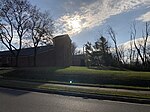St James Episcopal Church (Baltimore, Maryland)
African-American historic placesAfrican-American history in BaltimoreAfrican-American segregation in the United StatesChristianity and raceEpiscopal Church (United States) ... and 4 more
Episcopal church building in BaltimoreEpiscopal church buildings in MarylandHistory of racial segregation in the United StatesSandtown-Winchester, Baltimore

St. James Episcopal Church Lafayette Square, or St. James African Episcopal Church, founded in 1824, is a historic Episcopal church now located at 1024 W. Lafayette Avenue in the Lafayette Square Historic District of Baltimore, Maryland.In 2020, it reported 432 members, 95 average attendance, and plate and pledge income of $317,553.
Excerpt from the Wikipedia article St James Episcopal Church (Baltimore, Maryland) (License: CC BY-SA 3.0, Authors, Images).St James Episcopal Church (Baltimore, Maryland)
West Lafayette Avenue, Baltimore Sowebo
Geographical coordinates (GPS) Address External links Nearby Places Show on map
Geographical coordinates (GPS)
| Latitude | Longitude |
|---|---|
| N 39.299 ° | E -76.6355 ° |
Address
Saint James Episcopal Church
West Lafayette Avenue
21216 Baltimore, Sowebo
Maryland, United States
Open on Google Maps










